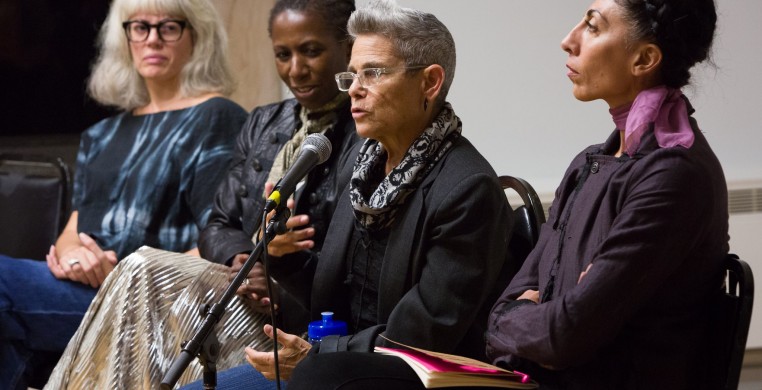Women in dance: "We're going to do it anyhow."
By Lauren Warnecke
It was a rainy night Nov. 2, with the Cubs’ World Series victory on the line in Cleveland. And so it was a small and dedicated group that gathered for the third of three Audience Architects 2016 Moving Dialogs panels dedicated to “Women in the Director’s Chair.” This installment featured Yanira Castro, Keesha Beckford, JoAnna Mendl Shaw and Nejla Yatkin, each selected for her innovative, pioneering spirit. In her introduction, moderator Sandra Kaufmann cited the monomyth, or “The Hero’s Journey,” in which the mythical protagonist (like Frodo, Han Solo, Atreyu) traipses into the unknown, carving the way bravely through a forest that has no path. Indeed, there are few examples from which any of these women can draw; as performers and directors, choreographers and educators, they have created or reimagined the artist/audience relationship, and worked within and between seemingly disparate disciplines that are, in some cases, entirely unique. The evening was less conversational than I think anyone anticipated, perhaps on account of a strict end time (because, Cubs…), but perhaps more so because each of the women on the panel could speak so thoroughly and elegantly about her work.
As founder of the interdisciplinary collaborative a canary torsi, NYC-based Yanira Castro said she continually questions “how it is that we gather,” and the agency of the audience within a performance experience. With a penchant for blurring the boundaries between artist and audience, her work is participatory, engaging, and different every time. After an extensive performance career, Keesha Beckford transitioned from dancing to writing when she had children. Her Huffington Post column and blog called Mom’s New Stage are like “real talk” for dance, giving a voice to and validating the experiences of women, particularly women of color, who happen to be moms. JoAnna Mendl Shaw is a well-respected educator whose long career included positions in the dance programs at Cornish College for the Arts, The Juilliard School, Tisch School of the Arts at NYU, Marymount Manhattan College and Fordham University. The NYC-based Shaw is frequently away from the city, best known for her large scale, site-specific dances incorporating horses. Nejla Yatkin has been based in Chicago for a few years, but spent very little of the last year here. The Princess Grace awardee and recent 3Arts grant recipient’s latest project called Dancing Around the World brought her to more than a dozen countries to create and document a dialogue with various cultures through a common language: movement.
In hearing each artist introduce herself and her work, the topic of the night, "Women in the Director’s Chair," never came up. Questions from the audience were aimed at better understanding each’s creative process, or the logistics of making seemingly impossible projects come to life, or simply fan girl-ing over this phenomenal panel of artists. When being women finally came up, it was about change: Has the experience of female choreographers changed over time? Are female choreographers perceived differently in other regions, or other countries, or other continents?
The panel didn’t, immediately, have any answers. “Has it changed?” said JoAnna Mendl Shaw, whose career has spanned four decades and reached every corner of the country, “Not a whole lot, actually. But I think you’re looking at women who are going to do this no matter what, so maybe that’s really the question… I want to empower women, but I’m going to do this anyhow.”
In his 2013 oft-cited article in The Guardian, Luke Jennings wrote about the dearth of female choreographers in the UK: “It's 14 years since a woman was commissioned to create a main-stage ballet at the Royal Opera House… Looking at pioneer dance-makers like Bronislava Nijinska, Isadora Duncan and Agnes de Mille, [historian Lynn] Garafola notes that while women are invariably in the vanguard of any new dance endeavour, men soon step in if the project is successful.” Jennings' comments, and their aftermath, brought about a flurry of conversations and initiatives related to the gender gap at the top of a field that is predominantly female.
What is lacking about Jennings’ report, however – and, for that matter, many attempts at addressing this issue – is the assumption that all choreographers define success the same way. Creating a ballet at the Royal Opera House may or may not (likely not) be these four women’s definitions of success, and yet the relative absence of women in leadership roles above a particular budget size is still concerning. To Mendl Shaw’s previous point, women are "going to do it anyhow," and the solution perhaps lies in how artists really define success, and the agency we give women to pursue those definitions for themselves. If the Royal Opera House is truly a barometer for success, how do we get women there? If it’s not, how do we promote, fund, and support platforms for women to continue “The Hero’s Journey,” and make the work that they really care about?
In total, Moving Dialogs’ three panels featured more than a dozen artists, spanned a year, and covered a wide range of topics related to women in dance. The series has perhaps raised more questions than answers, but one thing is clear: women have been and will continue to push the field forward. They are creating innovative and imaginative work. Where are all the women choreographers? They’re here. They’re working tirelessly, regardless of pay or recognition. The question is not “where are they?” but “how can we do a better job acknowledging, supporting, and advocating for them?”
Lauren Warnecke is a freelance writer, educator, and fitness professional based in Chicago, IL. A regular contributor to SeeChicagoDance.com, Windy City Times, and Chicago Magazine, she is the founder of the critical dance blog Art Intercepts.

